1935 Wheat Penny Coin Value: How Much Is It Worth?
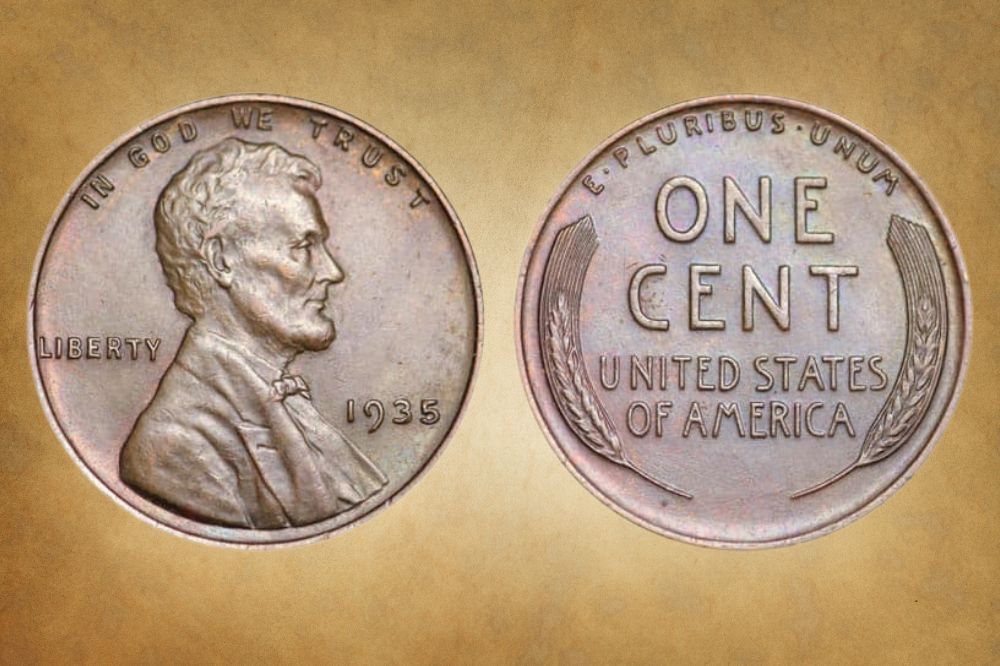
Coins do well during anniversary years, so a good time to sell your 1935 Wheat Penny would be … 2035! But you can still trade them today, especially if they’re in good condition. So let’s take a closer look at this Wheat Cent and accurately assess the 1935 Wheat Penny Value.
1935 Wheat Penny Value Chart |
|||||
| Mint Mark | Good (G 4) | Fine (F 12) | Extremely Fine (EF 40) | Uncirculated (MS 60) | Mint State (MS 63) |
| 1935 (P) No Mint Mark Wheat Penny Value | $0.17 | $0.22 | $0.56 | $3.30 | $6.64 |
| 1935-S Wheat Penny Value | $0.17 | $0.28 | $2.28 | $13 | $19 |
| 1935-D Wheat Penny Value | $0.17 | $0.22 | $0.56 | $5.70 | $9.13 |
1935 Wheat Penny Value Guide
Wheat Pennies were mostly copper, though the addition of zinc or tin made them less likely to turn green. Their color is still a big factor when you’re assessing their value though. So they’re typically color-graded as RD for red, RB for reddish-brown, or BN for brown, with RD being the most desirable grade. Now let’s look closer at the individual minting locations.
1935 (P) No Mint Mark Wheat Penny Value
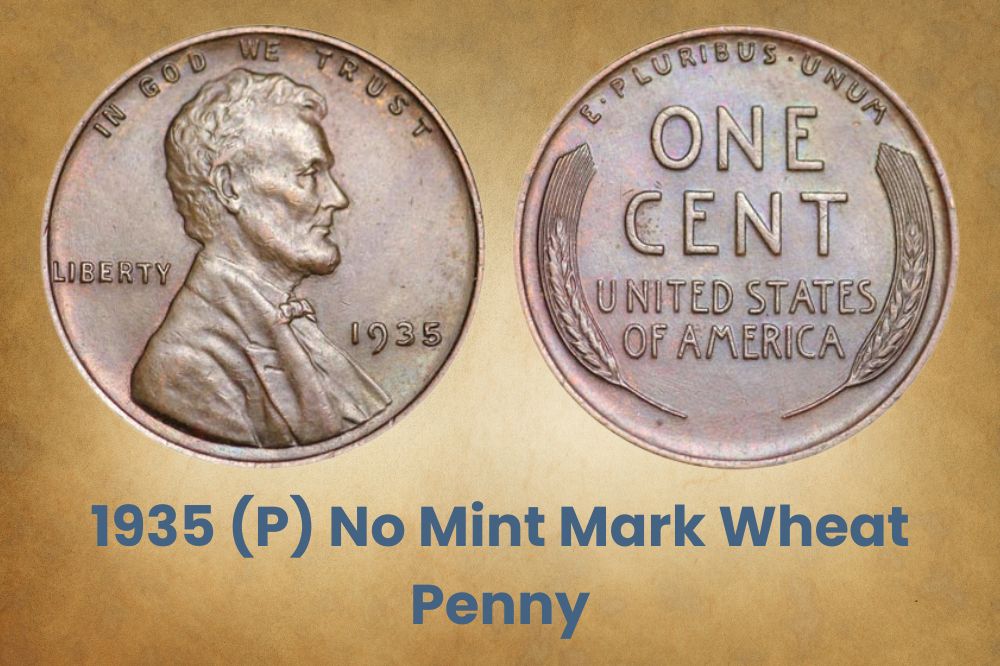
In 1935, the Philadelphia Mint made 245,388,000 Wheat Pennies without mint marks. In MS 68 RD, it had a record sale of $12,000. Timing is a huge factor in fetching such prices.
1935-S Wheat Penny Value
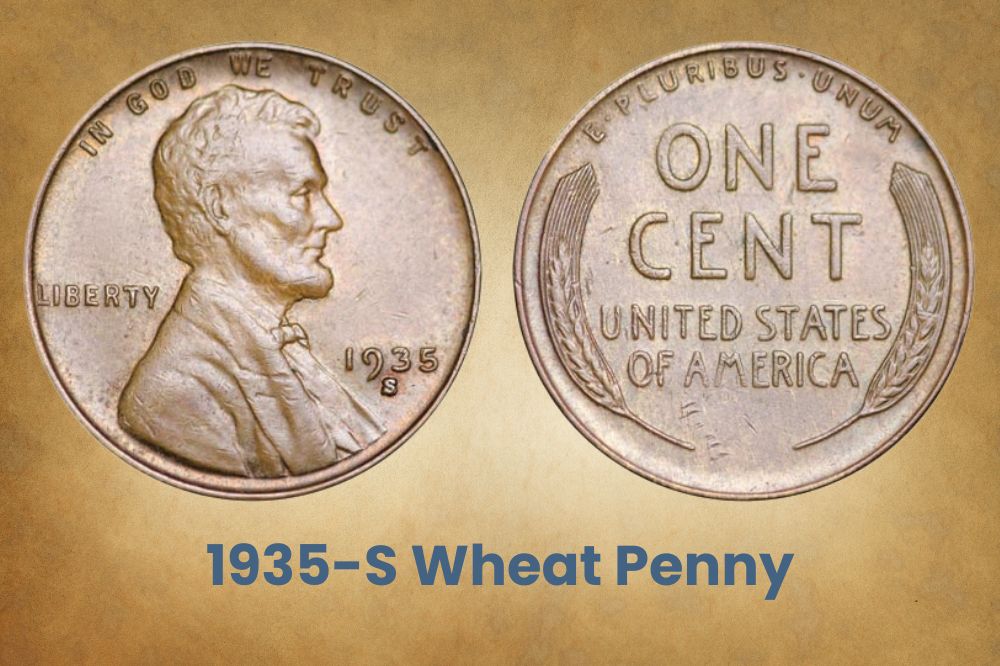
The San Francisco Mint made 38,702,000 Wheat Cents in 1935. In MS 67 RD, this coin once sold for over $10,000. That price depends on the date of sale though. It can go much lower.
1935-D Wheat Penny Value
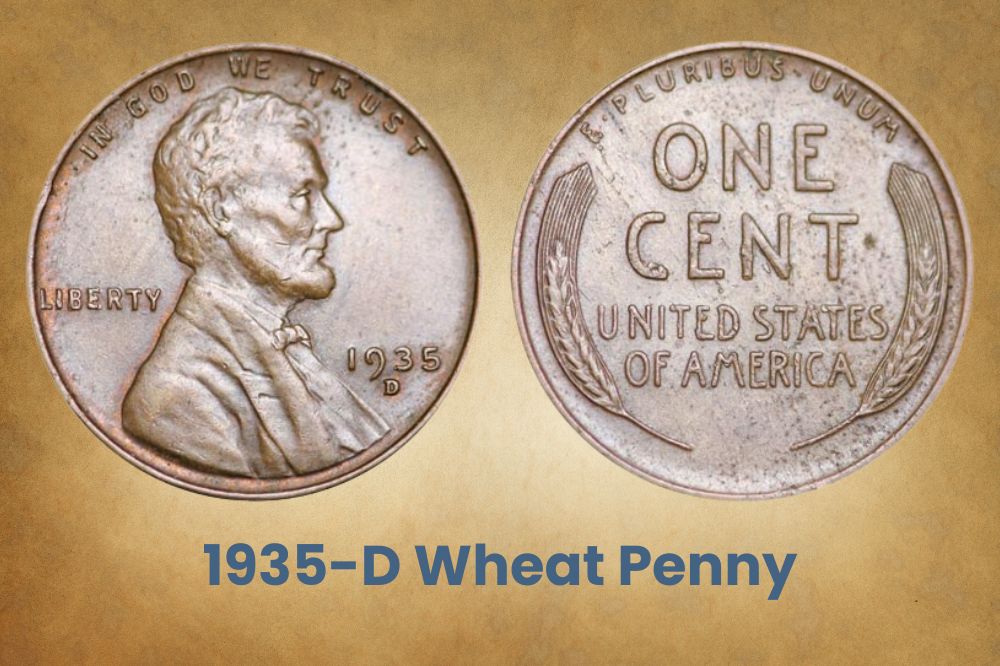
1935 saw 47,000,000 Wheat Pennies coined at the Denver Mint. In MS 67+ RD, this coin can sell for around $3,000 due to its pristine color, rarity, and superior mint condition.
Related Posts: 16 Most Valuable Wheat Penny Errors
1935 Wheat Penny Errors
Four things can give a coin premium prices: high mint states, rarity in the secondary market, desirable minting locations, and valuable errors. We’ve looked at the first three, so let’s dig into the fourth. For reference, most errors are caused by doubling or tripling in one form or another. You see, the prototype coin made by the artist is worked onto a steel master hub.
The master hub makes a master die, which makes a working hub, which makes working dies. These working dies are what eventually strike the planchet to make a coin. But the mint uses multiple strikes at every stage – hub, die, and planchet – so if the target moves at any stage, you’ll get double errors like DDOs, TDRs, off-centers, or even RPMs. Let’s take a closer look.
1935 Wheat Penny DDO Error
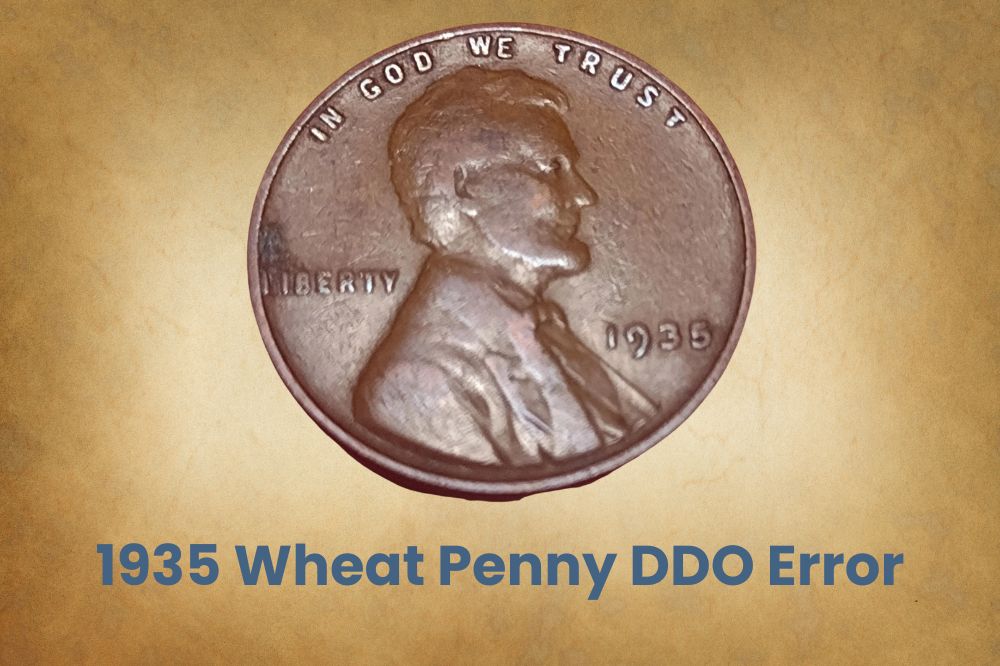
DDO means doubled-die obverse. It happens if the die shifts between multiple hub strikes. And it counts as a variety because this flaw will be reproduced on every coin that gets struck by that die. Check the date with a coin microscope or jeweler’s loupe – you can see the doubling most clearly on the 9, 3, and 5. It’s worth $60 in AU 53 and $500 in MS 65 RD.
History of the 1935 Wheat Penny
Most people start with pennies when they get into coin collecting. They’re quite common, so you could even find one lying on the street! And that pretty red color is a huge draw as well. For kids, the size of these 1c coins appeals to their tiny hands. They can amass a huge stash as adults give them ‘worthless’ cents from spare change. But pennies hold historic value too.
For one thing, the Wheat Penny was the first coin to feature an American President. How come? Well, we used to be a UK Colony, so our earliest coins had kings and queens from the British Empire. And once we gained independence, our Founding Fathers officially shot down lots of colonial practices, including the idea of putting our leaders’ faces on US coins.
George Washington, the 1st US President, was especially against this practice, so it wasn’t implemented until 1909. That said, Washington himself was placed on a $1 bill in 1869, though he didn’t appear on a coin until 1932. It was a 25c coin aka the Quarter, and he was placed there in honor of his bicentennial birthday. But let’s get back to Wheat Pennies.
In 1909, it had been 100 years since Abraham Lincoln’s birth. And starting in 1904, sitting President Theodore Roosevelt launched an initiative to make American coins look more artistic. So in 1909, as part of this coin beautification project, the mint released the Lincoln Cent to honor our 16th President. The public loved the coin – the mint didn’t!
There were lots of reasons why mint officials disliked the 1909 Wheat Penny, but first, some housekeeping. All American Pennies are Lincoln Cents because they all have Lincoln on the heads side. But the reverse has changed multiple times, so these coins are categorized based on their backside. The Wheat Cent was the first in the series, and it featured wheat stalks.
President Roosevelt’s 1904 Coin Project
Before 1857, pennies were much larger – almost 3cm in diameter. But as copper prices rose, the melt value of large cents surpassed their face value, so the mint made these coins smaller to accommodate the price change. The Lincoln Cent was one of the smaller series of pennies and measured 19.05mm across. It was 95% copper with some tin and zinc to make it harder.
Let’s talk about Roosevelt’s displeasure with American money. One of the reasons our coins were so plain is that they were designed by in-house mint engravers. These artists were tied down by practical concerns, not just aesthetic ones. They ran the mint like a factory whose aim was maximum speed and profit, so they designed coins that were cheap and fast to mint.
This meant the coins had simple imagery and low profiles, to ensure dies lasted longer and maximized seignorage. Seignorage is the difference between the production cost and the face value of a coin, and it’s a source of mint revenue. Also, while modern coins are minted using expensive equipment, Ancient Greek and Roman coins were carved and engraved by hand.
This process was much slower, but it allowed for high relief and detailed texture, so the coins were much prettier. And this was what Theodore Roosevelt had in mind when he asked for US coins to be redesigned. His solution was to hire external artists to accomplish the job that he felt in-house mint engravers couldn’t do. And this naturally led to a whole lot of trouble.
For one thing, commercial sculptors and mint engravers clashed over their approach. The mint engravers preferred flatter coins in simple styles that would let the dies last longer. But external artists wanted high relief and elaborate details that needed multiple strikes, and that meant more expense at the mint. Plus, the external designers were replacing in-house coins!
Augustus Saint Gaudens vs Charles Edward Barber
The Lincoln Wheat Penny suffered from these disagreements, and that was the impetus for much of its controversy. The designer who made the Wheat Penny was Victor David Brenner. He had worked under Augustus Saint-Gaudens, a close personal friend of President Theodore Roosevelt, and the first external artist hired for this coin beautification project.
Saint-Gaudens designed the gold eagle ($10), double-eagle ($20), and even a penny before he died of cancer in 1907. His penny was never minted or used, so one of his assistants, Victor Brenner, stepped in to complete the task. Unfortunately, he had to contend with the feathers his boss had ruffled, and Saint-Gaudens had been kicking up dust at the mint since 1891!
Even before this project began, Saint-Gaudens had tussled with Chief Mint Engraver Charles Barber on multiple occasions. Their differences weren’t necessarily personal. They probably came down to their world views regarding art. You see, Charles Barber was a 3rd Generation medal maker and engraver, following the example of his dad and granddad before him.
In fact, his immediate boss at the mint was his own father! So he was used to working on coins on small scales and without much fluff. He had even designed the Barber Coinage that was on dimes, quarters, and half dollars at the time, and was now being asked to replace his 25-year heritage with impractical, expensive coins that had elaborate décor and high relief.
The Controversy of Coin Accreditation and Designer’s Initials
On top of that, he was forced to work with commercial sculptors who – in his opinion – were more interested in building their reputations than saving the country money, pun intended. So when the Lincoln Wheat Penny was finally produced, his issues with it included the high relief – which he repeatedly flattened, and its close cropping, which he eventually loosened.
He was also concerned by Brenner’s eagerness to be recognized, first by placing his full name on the coin, and later by using a large font for his initials. For reference, mint engravers used a small letter to identify their designs, and the Barber Coinage only had a single B. This mess ended up with Brenner’s signature being scrubbed off the coin until after Barber died in 1917.
But despite all these arguments and bad blood, the Lincoln Cent proved so popular that even today, when it can barely buy anything and costs 2 cents to make (meaning the mint takes a loss of 200% for every penny it mints), the coin is still in production and defies bureaucratic attempts to phase it out. Also, while the 1935 Wheat Penny isn’t a key date, it holds merit.
How so? Well, the curvy design of the Wheat Cent made it hard to press proof coins, so the mint stopped doing so after 1917. But even the earlier proofs were matte because the relief of Lincoln Cents was tougher to polish. But starting 1936, the mint introduced modern proof coins with a mirrored finish, so high-quality non-proof pennies from 1935 can be worth a lot.
Related Posts: 19 Most Valuable Lincoln Memorial Penny Worth Money
How to Identify the 1935 Wheat Penny?
We’ll start with a refresher on important coin jargon, in case you’re unfamiliar.
- Collar – the raised rim or border of the coin.
- Device – the visual part of a coin e.g. image or portrait.
- Edge – the flat side of the coin that sometimes has reeds.
- Field – the backdrop or background of a coin.
- Legend / Motto – the text-based part of a coin i.e. the words.
- Mint Mark – the initials of the minting location i.e. which mint the coin was made in.
- Numismatist – A person who professionally studies and sometimes trades coins.
- Obverse – the front or ‘heads side’ of a coin.
- Planchet – the blank button-like disc that forms a coin.
- Reverse – the back or ‘tails side’ of a coin.
Now let’s look at the physical characteristics that identify the 1935 Wheat Cent.
The Obverse of the 1935 Wheat Penny
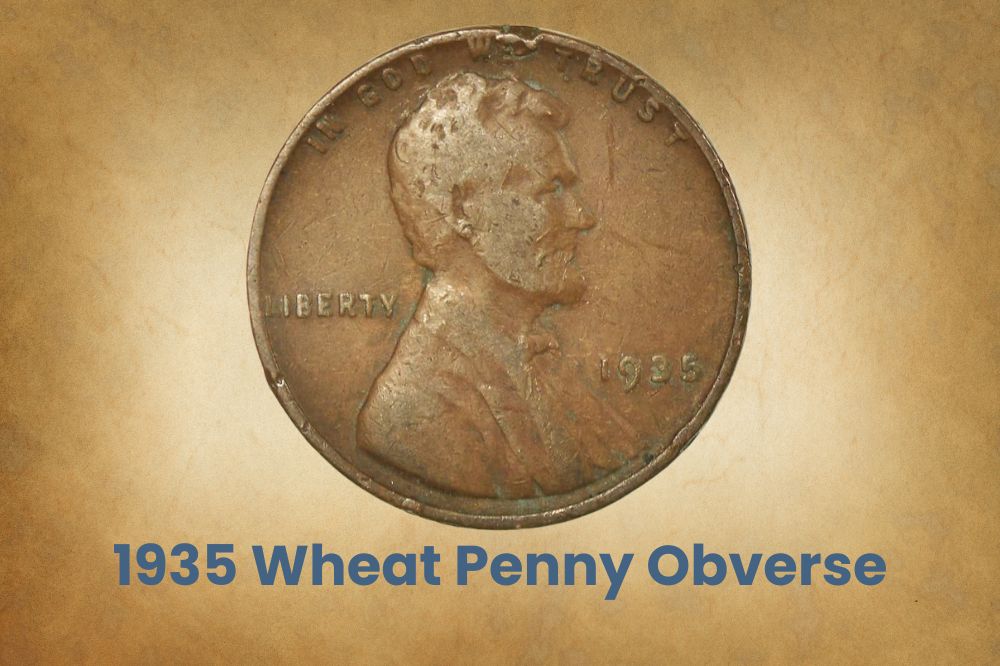
The obverse (heads side) of the 1935 Wheat Penny has a portrait of Abraham Lincoln facing right. And 1935 is well after the VDB mess, so Lincoln’s shoulder cut-off has the controversial designer’s initials. The top of the coin bears the motto In God We Trust, while the legend Liberty is on the right, behind Lincoln’s back. On the left are the mint mark and the mint date.
The Reverse of the 1935 Wheat Penny
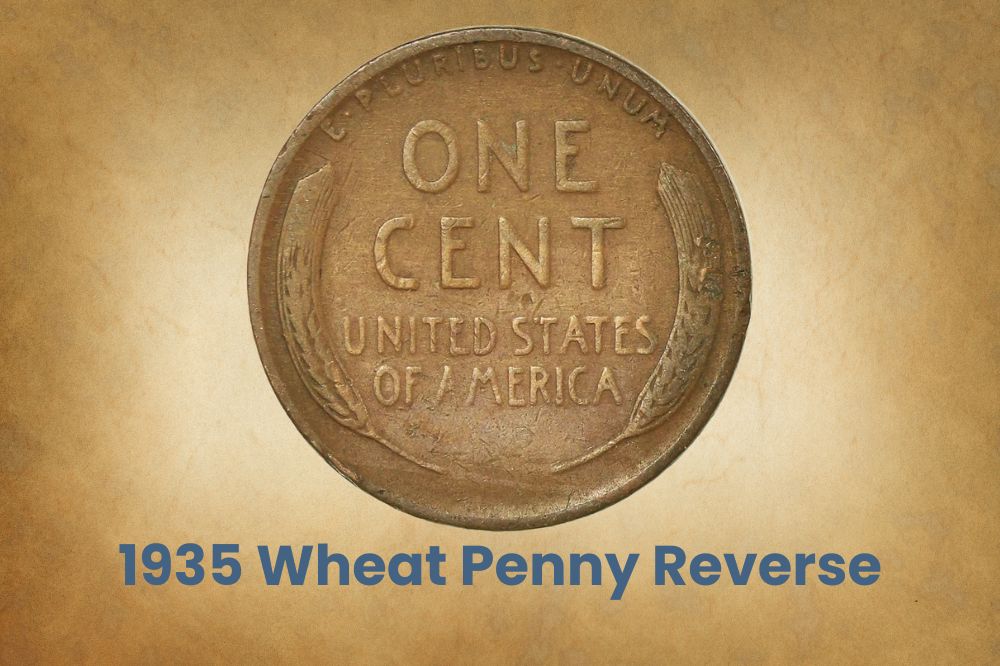
The reverse (tails side) of the 1935 Wheat Penny holds a pair of durum wheat stalks. They’re sometimes described as sheaves or ears of wheat, and they frame the writing on the coin. E Pluribus Unum runs between the tips of the wheat sheaves at the top. In the middle of the coin, you find the denomination, One Cent, followed by the legend United States of America.
Other Features of the 1935 Wheat Penny
The 1935 Wheat Penny was 95% copper with the remainder in either zinc or tin, though they sometimes used a mixture of both base metals. The coin was 19.05mm in diameter and had a smooth or plain edge without any reeds. These bronze or brass coins weighed 3.11g and were coined at all three US mints. Philadelphia pennies never have mint marks except in 2017.
Related Posts: 19 Most Valuable Wheat Penny Worth Money
FAQs About the 1935 Wheat Penny
What Makes a 1935 Wheat Penny Valuable?
While we often used the words vintage and antique interchangeably, there’s a difference. Retro coins are old. Vintage items are 50 years or older, while antiques are at least 100 years old. A 1935 Wheat Penny is vintage, so that gives it value. Some have sold for $12,000!

I have one of the 35 wheat for sale and I’ll give it to you for half price
On our 1935 wheat penny not only the 3,5,9 have doubled die but the L in liberty is on the rim but the words in and we have very notice double die going on also is this normal for this no mint mark penny
I have a 1935 penny how can i value